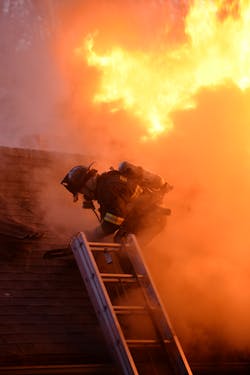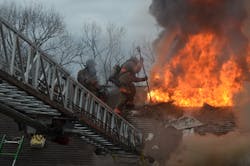The fireground is dangerous and can be unforgiving to crews that don’t perform safely and correctly. It isn’t a place to show up unrehearsed. As the basics of vertical ventilation were realized and the fundamentals were practiced, small gains in firefighting effectiveness were achieved.
Combined with experience, in time, vertical ventilation added up to a noteworthy skill and what some would call the bread and butter of what ladder companies do.
What follows is a look at residential vertical ventilation from dispatch to the completion of a “round trip” off of the roof. From coast to coast, there are different types of residential roofs, including tile and steeply pitched roofs. The latter two examples require a specific ventilation technique that isn’t covered in this article, although much of the basics that are discussed here can be applied.
Size-up
Size-up begins upon receipt of the alarm. Crews that have a working knowledge of the type of construction of homes in their first-due area can begin to mentally prepare a plan of action.
Listening to the radio for the report from on scene from the first-in company or to alarm room updates also helps to formulate a game plan.
Prior to dismounting the truck, crew members should know: their role; which tools that they are expected to carry; the proper length ground ladder to throw to the roof; who is addressing utilities; specific duties on the roof; cut sequences; and where to walk. On the way to the fire is the wrong time to make assignments.
As the air brakes on the ladder are engaged, this is a good time for the company officer to take a mental snapshot of conditions. Where and what type of smoke or fire is emitting from the house? Does it appear to be a room-and-contents fire, or is the structure involved? Does it have smoke under pressure, which indicates high heat, or does it appear to be an attic fire, showing from one or both gable ends?
By the time that the crew actually “makes” the roof, there is a good chance that conditions will look different, and knowing how and where the fire changed is good information.
If possible, the company officer should look in the backyard. This can offer a visual clue to what the conditions are like. Many times, for example, the seat of the fire can be confirmed as it roars out of a back-bedroom window, which indicates exactly where to efficiently ventilate above it.
While conducting a size-up, the crew can educate themselves on conditions, such as looking at the roof eaves. Sometimes, homeowners re-roofed the house by only adding new asphalt shingles and not removing the old ones. In such a circumstance, anticipate a thicker roof deck and a slower pace for using the chainsaw.
Ground ladders
Locate ground ladders on the corner of the house where the structure is strongest; avoid placing them in front of doors and windows.
Often, throwing a 16-foot straight ground ladder on a single-story house is the right choice. If using an extension ladder for a two-story house, remember to have the fly section out or away from the house. This is a requirement of NFPA 1932: Standard on Use, Maintenance, and Service Testing of In-Service Fire Department Ground Ladders.
When placing ground ladders, also be aware of unstable ground surfaces, obstructions on the ground, overhead wires, tree limbs and hard surfaces, such as concrete driveways. The latter is important if the butt end/spur of a ladder lacks a pad, because a ladder that’s placed on concrete easily could slip unless someone is carefully bracing the ladder with his/her foot (known as footing).
Prior to climbing, make sure that if you’re using a halyard that it’s correctly tied off. As well, check for a good climbing angle, extend the ladder about three rungs above the roof line and don’t move a ladder once it’s in place, because firefighters who are on the roof expect it to be there when they exit. (Placing a second ladder for another means of egress is a good idea.)
Prior to accessing the roof
Your department’s level of staffing and standard operating procedures (SOPs) will dictate how many firefighters go to the roof, but using three people to accomplish the ventilation hole provides for a good distribution of workload and a manageable number of firefighters for the company officer to oversee. A fourth crew member can secure utilities and then become the eyes on the ground for the crew on the roof. (Remember, not all houses have both electric and gas supplies, but if both are secured, be specific when reporting that to the incident commander [IC].)
Prior to accessing the roof, from the ground, the company officer can use a thermal imaging camera (TIC) to see whether there are any indications of a hot spot on the roof, which could assist in picking a safe and effective ventilation location. (Note: TICs don’t show a heat signature very well on a roof that’s heated by the sun.) You can continue to use the TIC when climbing off of the ladder on to the roof to reinforce the findings from the ground.
Equipment that’s brought to the roof can vary by department, but bringing two chainsaws offers an option if there is a mechanical problem with one of them. The other tools that typically are brought up are: at least one flathead axe (in case both saws fail, you can use the flat part of the axe to produce makeshift “cuts” in the roof to create a hole) and a trash hook to sound the roof.
Always wear your full PPE—no exceptions—and train with it on, so you’re comfortable wearing it while climbing and using the saw. (Practicing at night is a smart idea, too. Most training is during the day in near perfect conditions.)
When training, be mindful of the ventilation process on a very familiar prop. Make sure that the repetition of rolling trusses that are located in the same spot and the obvious parameters of the vent hole don’t lead to complacency. Remember: Routine becomes lethal when you can’t see the purpose of it.Roof operations
The company officer should lead the crew onto the roof and carry a trash hook and TIC. He/she should begin to sound the roof even before stepping on it.
When walking the roof, make sure to sound it with enough force to simulate your weight. This action can indicate when roof integrity might be compromised, because the supporting trusses are weakened by fire.
To reduce the chance of creating a concentrated load, crew members should keep about four feet between each other while advancing on the roof. Use your personal light at night, and avoid stepping where you can’t see. Take into account the wind direction, if possible, when choosing what side of a peaked roof to ventilate. High winds can push the smoke that emits from your vent hole right back into the attic space or at least limit the release of pressurized smoke and heat.
The company officer should walk as close to over the seat of the fire as is safe, make a 90-degree turn and sound the area that’s to be cut, which is usually near the peak as high up on the roof as possible. Experience has shown that a 4 x 8-foot hole works well on houses that have modern (read: substantially synthetic construction) furnishings. (A pound of burning plastic produces 500 more times the amount of smoke and more BTUs than a pound of burning wood.) This size hole reduces the risk of the fire spreading through the attic; a smaller hole—say, a 4 x 4-foot—could prevent rising BTUs from escaping fast enough to eliminate the chance that heat and smoke would spread laterally. A 4 x 8-foot hole also reduces the need to invest precious time to enlarge a smaller hole or to cut additional holes.
According to the 2013 Study of the Effectiveness of Fire Service Vertical Ventilation and Suppression Tactics in Single Family Homes, which was conducted by UL Firefighter Safety Research Institute (UL FSRI) and was authored by Stephen Kerber, “Once the fire was fuel-limited, the larger the hole, the better conditions became for any potential victims or firefighters operating inside the structure.”
All of this said, an additional hole(s) could be necessary if the company officer doesn’t believe that there is enough relief of BTUs/heat/smoke to effectively relieve conditions below and make matters more tenable for interior crews. If an additional hole is needed, move from the first hole toward the egress and a safe area.
The UL FSRI study also notes, “Ventilating over the fire is the best choice if your fire attack is coordinated.”
The sequence of cuts to create the ventilation hole should be a well-rehearsed “dance” based on department SOPs or the company officer’s preference and experience. Also, be aware of your chainsaw depth to avoid cutting through the supporting trusses. As ventilation operations begin, the company officer should place him/herself in a safe position to monitor roof conditions and to allow for more favorable radio communications.
Coordinating with interior crews
Before opening up the louvers on your ventilation hole, make sure the roof sector/group or the IC coordinated with interior crews about the application of water on the fire. The ventilation opening will create an air flow path that most likely started at the opening of the front door. This will cause an increase in the heat release rate, which allows the fire to grow until water takes away the energy and reduces its growth, which is when vertical ventilation works best.
Reports from interior crews that indicate when suppression efforts are beginning are “golden nuggets” to the IC, and this information helps to achieve the tactical goal of improving survivability for victims and firefighters.
It’s a good idea to develop hand signals or a way to communicate on the roof other than by talking, given the noise from the chainsaw. It’s important to point out that any cuts that are made on the roof should include a 4-inch overlap. This reduces the force that’s needed to open up louvers and makes the process faster.
Coincidentally, when creating louvers with the roof deck, make sure that they are positioned so the wind won’t catch the louver and be channeled downward into the attic, but, instead, be deflected upward and away from the attic.
After opening up the roof decking, make sure the ceiling below has been punched through with the trash hook to release heat and smoke from inside of the house. Be wary that the attic is a common storage area and that you might encounter items that will keep you from successfully breaching the ceiling.
After successfully completing this entire vertical ventilation process, the company officer will lead off of the roof, sounding as the crew walks the same route (if safe to do so). Before exiting off of the roof, at a safe location, the company officer will give the IC a complete roof report, painting an accurate picture of conditions and confirming the integrity of the roof.
Once the crew is on the ground, the company officer should give the IC a personnel accountability report (PAR) notification, including the fourth firefighter who didn’t go to the roof. Prior to communicating a PAR, it’s advisable to get a low-air reading from the crew and to ask members how they feel, in anticipation of being given another assignment from the IC.
Finally, as an act of customer service, after the fire is out, overhaul is complete and as much residual smoke as possible has exited the structure, nail down a piece of heavy plastic material with wood furling strips to cover the hole that was created in the roof. This will prevent rain or snow from entering and causing further damage.
Back to basics
There is nothing more rewarding to a firefighter than a successful outcome of a job that results from time spent understanding the essentials. A properly completed vertical ventilation hole will improve tenability for crews on the inside, help in search-and-rescue efforts and reduce property damage from smoke.
According to the NFPA, from 2013–2017, U.S. fire departments responded on average to 345,000 house fires annually. Odds are, you’ll get your chance to get back to basics.
The Company Officer’s Role in Vertical Ventilation
During residential vertical ventilation, the company officer’s primary responsibility is to ensure the safety of his/her crew and to facilitate the coordination of the crew’s task as part of the overall incident strategy.
This pivotal role and the leadership and knowledge that goes with it never is more apparent than when on the roof of a burning house.
- During the vertical ventilation process, the company officer’s objectives are:
- Confirm a structurally safe working surface and direct ventilation operations.
- Coordinate the timing of vertical ventilation with interior crews and/or the incident commander.
- Develop a plan for where and how ventilation will occur.
- Continually monitor safety of rooftop operations and fire conditions.
- Report the success or inability to complete a vent hole, including the reason why not in the case of the latter. This should be in the form of a roof report.
- Safely exit off of the roof and provide a personnel accountability report when down on the ground.
About the Author

Gibby Gorman
Gibby Gorman recently retired from his fire service career after nearly 33 years, which began in 1986 with the Tempe, AZ, Fire and Medical Department, where he served for 27 years. During that time, Gorman: worked as a downtown ladder captain for 14 years; responded on the SCUBA Rescue Team; worked on the hazmat team; served as coordinator for the Regional Technical Rescue Teams; taught fire science classes at the community college level; and presented ladder tactics for Firehouse World conferences,, including in 2020. In 2013, he became a battalion chief for the Maricopa, AZ, Fire and Medical Department. Gorman created Southwest Firefighting Concepts. He received his bachelor’s degree from Arizona State University.

